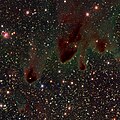| Supernova remnant | |
|---|---|
 The Gum Nebula in H-alpha | |
| Observation data: J2000.0 epoch | |
| Right ascension | 08h 00m |
| Declination | −43° 00′ |
| Distance | 1470 ly (450 pc) |
| Apparent magnitude (V) | +12 (infrared only) |
| Apparent diameter | 30° |
| Constellation | Vela, Puppis |
| Physical characteristics | |
| Absolute magnitude (V) | 3.73 (infrared) |
| Designations | Gum 12 |
The Gum Nebula (Gum 12) is an emission nebula that extends across 36° in the southern constellations Vela and Puppis. It lies approximately 450 parsecs from the Earth.[1] Hard to distinguish, it was widely believed to be the greatly expanded (and still expanding) remains of a supernova that took place about a million years ago. More recent research suggests it may be an evolved H II region. It contains the 11,000-year-old Vela Supernova Remnant, along with the Vela Pulsar.
The Gum Nebula contains about 32 cometary globules.[2] These dense cloud cores are subject to such strong radiation from O-type stars γ2 Vel and ζ Pup and formerly the progenitor of the Vela Supernova Remnant that the cloud cores evaporate away from the hot stars into comet-like shapes. Like ordinary Bok globules, cometary globules are believed to be associated with star formation.[3] A notable object inside one of these cometary globules is the Herbig-Haro object HH 46/47.
It is named after its discoverer, the Australian astronomer Colin Stanley Gum (1924–1960). Gum had published his findings in 1955 in a work called A study of diffuse southern H-alpha nebulae (see Gum catalog). He also published the discovery of the Gum Nebula in 1952 in the journal The Observatory. The observations were made with the Commonwealth Observatory.[4]
The Gum nebula was photographed during Apollo 16 while the command module was in the double umbra of the Sun and Earth, using high-speed Kodak film.[5]



